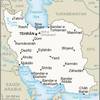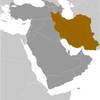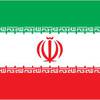Iran [+]Compare [E]dit [H]istory
Aliases: Islamic Republic of Iran, Jomhuri-ye Eslami-ye Iran, PersiaObject «Iran» was created due to
Add new object to «Iran» or move existing objects here.
Object «Iran» has attributes [Show empty attributes][Hide empty attributes]
| Attribute | Value |
|---|---|
| Geography | |
| Area | 1,648,195 km² |
| Continent | Asia |
| Land area | 1,531,595 km² |
| Water area | 116,600 km² |
| Land boundaries | 5,894 km |
| Border countries |
|
| Coastline | 2,440 km |
| Mean elevation | 1,305 m |
| Lowest point | -28 m |
| Highest point | 5,625 m |
| People | |
| Population | 84,923,314 |
| Official languages |
|
| Religion | Muslim |
| Government | |
| Long country name | Islamic Republic of Iran |
| Short country name | Iran |
| Long local name | Jomhuri-ye Eslami-ye Iran |
| Short local name | Iran |
| Former name |
|
| Government type | Theocratic republic |
| Capital | Tehran |
| Economy | |
| GDP (PPP) | 1,640,000,000,000 USD |
| GDP (OER) | 430,700,000,000 USD |
| GDP (real growth rate) | 3.7 % |
| GDP - per capita (PPP) | 20,100 USD |
| Gross national saving | 37.9 % of GDP |
| Labor force | 30,500,000 |
| Unemployment rate | 11.8 % |
| Population below poverty line | 18.7 % |
| Budget revenues | 74,400,000,000 USD |
| Budget expenditures | 84,450,000,000 USD |
| Military expenditures | 2.67 % of GDP |
| Taxes and other revenues | 17.3 % of GDP |
| Budget surplus or deficit | -2.3 % of GDP |
| Public debt | 39.5 % of GDP |
| Inflation rate | 9.6 % |
| Central bank discount rate | Add |
| Commercial bank prime lending rate | 18 % |
| Stock of narrow money | 48,080,000,000 USD |
| Stock of broad money | 48,080,000,000 USD |
| Stock of domestic credit | 348,200,000,000 USD |
| Market value of publicly traded shares | 89,430,000,000 USD |
| Current account balance | 9,491,000,000 USD |
| Exports | 101,400,000,000 USD |
| Imports | 76,390,000,000 USD |
| Reserves of foreign exchange and gold | 120,600,000,000 USD |
| External debt | 7,995,000,000 USD |
| National currency | Iranian rials |
| National currency (code) | IRR |
| National currency (symbol) | ﷼ |
| National currency rate to USD | 32 |
Known as Persia until 1935, Iran became an Islamic republic in 1979 after the ruling monarchy was overthrown and Shah Mohammad Reza PAHLAVI was forced into exile. Conservative clerical forces led by Ayatollah Ruhollah KHOMEINI established a theocratic system of government with ultimate political authority vested in a learned religious scholar referred to commonly as the Supreme Leader who, according to the constitution, is accountable only to the Assembly of Experts (AOE) - a popularly elected 88-member body of clerics. US-Iranian relations became strained when a group of Iranian students seized the US Embassy in Tehran in November 1979 and held embassy personnel hostages until mid-January 1981. The US cut off diplomatic relations with Iran in April 1980. During the period 1980-88, Iran fought a bloody, indecisive war with Iraq that eventually expanded into the Persian Gulf and led to clashes between US Navy and Iranian military forces. Iran has been designated a state sponsor of terrorism for its activities in Lebanon and elsewhere in the world and remains subject to US, UN, and EU economic sanctions and export controls because of its continued involvement in terrorism and concerns over possible military dimensions of its nuclear program. Following the election of reformer Hojjat ol-Eslam Mohammad KHATAMI as president in 1997 and a reformist Majles (legislature) in 2000, a campaign to foster political reform in response to popular dissatisfaction was initiated. The movement floundered as conservative politicians, supported by the Supreme Leader, unelected institutions of authority like the Council of Guardians, and the security services reversed and blocked reform measures while increasing security repression. Starting with nationwide municipal elections in 2003 and continuing through Majles elections in 2004, conservatives reestablished control over Iran's elected government institutions, which culminated with the August 2005 inauguration of hardliner Mahmud AHMADINEZHAD as president. His controversial reelection in June 2009 sparked nationwide protests over allegations of electoral fraud, but the protests were quickly suppressed. Deteriorating economic conditions due primarily to government mismanagement and international sanctions prompted at least two major economically based protests in July and October 2012, but Iran's internal security situation remained stable. President AHMADINEZHAD's independent streak angered regime establishment figures, including the Supreme Leader, leading to conservative opposition to his agenda for the last year of his presidency, and an alienation of his political supporters. In June 2013 Iranians elected a centrist cleric Dr. Hasan Fereidun ROHANI to the presidency. He is a longtime senior member in the regime, but has made promises of reforming society and Iran's foreign policy. The UN Security Council has passed a number of resolutions calling for Iran to suspend its uranium enrichment and reprocessing activities and comply with its IAEA obligations and responsibilities, and in July 2015 Iran and the five permanent members, plus Germany (P5+1) signed the Joint Comprehensive Plan of Action (JCPOA) under which Iran agreed to restrictions on its nuclear program in exchange for sanctions relief. Iran held elections in 2016 for the AOE and Majles, resulting in a conservative-controlled AOE and a Majles that many Iranians perceive as more supportive of the ROHANI administration than the previous, conservative-dominated body. RUHANI was reelected president in May 2017. Economic concerns once again led to nationwide protests in December 2017 and January 2018 but they were contained by Iran's security services. In May 2018, the US withdrew from the JCPOA and reinstituted economic sanctions on Iran in November.
Similar objects
Most often compared with
Everyone can something to edit or add.
There was one edit, no edits waiting approval. Last edited by mann.zelma(9435), Sep 16, 2019 (63 fields were changed)
Help · Contact us · Disclaimer · Contributors · Developers · Donate


